Disclosure: Meeple Mountain received a free copy of this product in exchange for an honest, unbiased review. This review is not intended to be an endorsement.
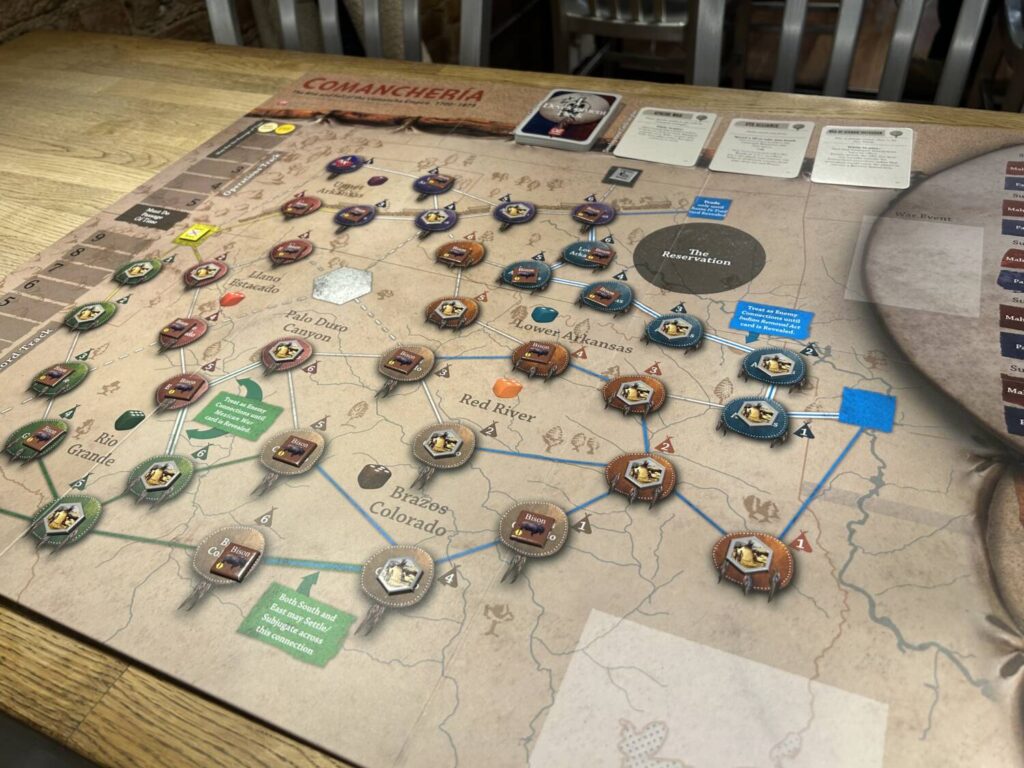 I acquired my copy of the first edition of Comanchería in a trade, swapping it for Isle of Cats on a rainy street corner in Brooklyn one summer night. It represented a departure for me. While I played a number of small solo games during the early days of COVID–Onirim, Herbaceous, and Friday were on constant rotation–Comanchería was the first heavy solo game I picked up. I knew I was interested in the theme, the rise and fall of the Comanche empire, and that was enough.
I acquired my copy of the first edition of Comanchería in a trade, swapping it for Isle of Cats on a rainy street corner in Brooklyn one summer night. It represented a departure for me. While I played a number of small solo games during the early days of COVID–Onirim, Herbaceous, and Friday were on constant rotation–Comanchería was the first heavy solo game I picked up. I knew I was interested in the theme, the rise and fall of the Comanche empire, and that was enough.
It took me about six months to get it to the table, which isn’t surprising. Assuming the game is going well—and that is a bold assumption—Comanchería can take the better part of a day. It also takes up a fair amount of space, requiring the kind of table space that New York City apartments don’t tend to provide. I didn’t finally sit down with the tutorial until Christmas, when I was able to leave it set out while visiting my parents.
Over the course of the next two or three days, I experienced a board game unlike any I had played before. Not just in terms of rules grit, though it certainly had more rules than most games I had played up to that point. Comanchería was my first historically-informed design, one in which specific mechanics and effects represent attempts to map historical events onto the game. I remember catching my breath—I did, in fact, gasp a little—with excitement when I saw that the card signaling the arrival of French fur traders up the Mississippi meant I could start performing the Trade action at any map location adjacent to the river. Everything about it made sense.
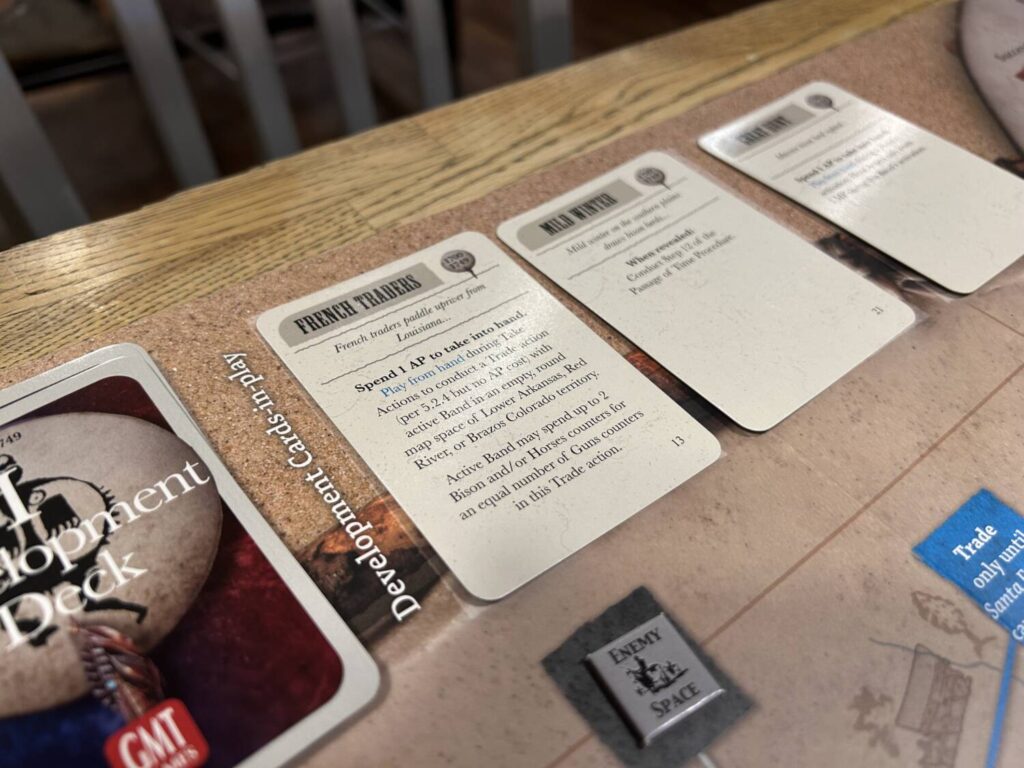 The tutorial is excellent. It leads you through three rounds, one step at a time, laying out every action you take and every chit you draw. In the process, it covers all the fundamentals in a way that makes much more sense than any GMT manual ever could. You send bands out to hunt, raid, and establish new settlements, all while dealing with various encroachers. The enemies are controlled via a chit pull system, a simple mechanism that injects some uncertainty in your plans and keeps things moving. Other than the odd bit of grit, the rules aren’t bad; in terms of complexity, like most GMT games, Comanchería’s bark is much worse than its bite.
The tutorial is excellent. It leads you through three rounds, one step at a time, laying out every action you take and every chit you draw. In the process, it covers all the fundamentals in a way that makes much more sense than any GMT manual ever could. You send bands out to hunt, raid, and establish new settlements, all while dealing with various encroachers. The enemies are controlled via a chit pull system, a simple mechanism that injects some uncertainty in your plans and keeps things moving. Other than the odd bit of grit, the rules aren’t bad; in terms of complexity, like most GMT games, Comanchería’s bark is much worse than its bite.
Every turn is divided into four phases. Three of those phases more or less run themselves, concerning the movements of opposing military forces and the passage of time. During the Operation Execution Phase—nobody said this was going to be sexy—you pick one of four options: Take Actions, Culture, Planning, and Passage of Time. The relationship between those four options, the ways in which they connect to one another and unspool a big-picture strategy, is hard to parse. Across five or six games over four years, I still cling to the excellent player aide to keep me grounded. It feels fitting, though. Why would the mechanisms through which you navigate the political realities of the time be rendered transparent? They weren’t then, they shouldn’t be now.
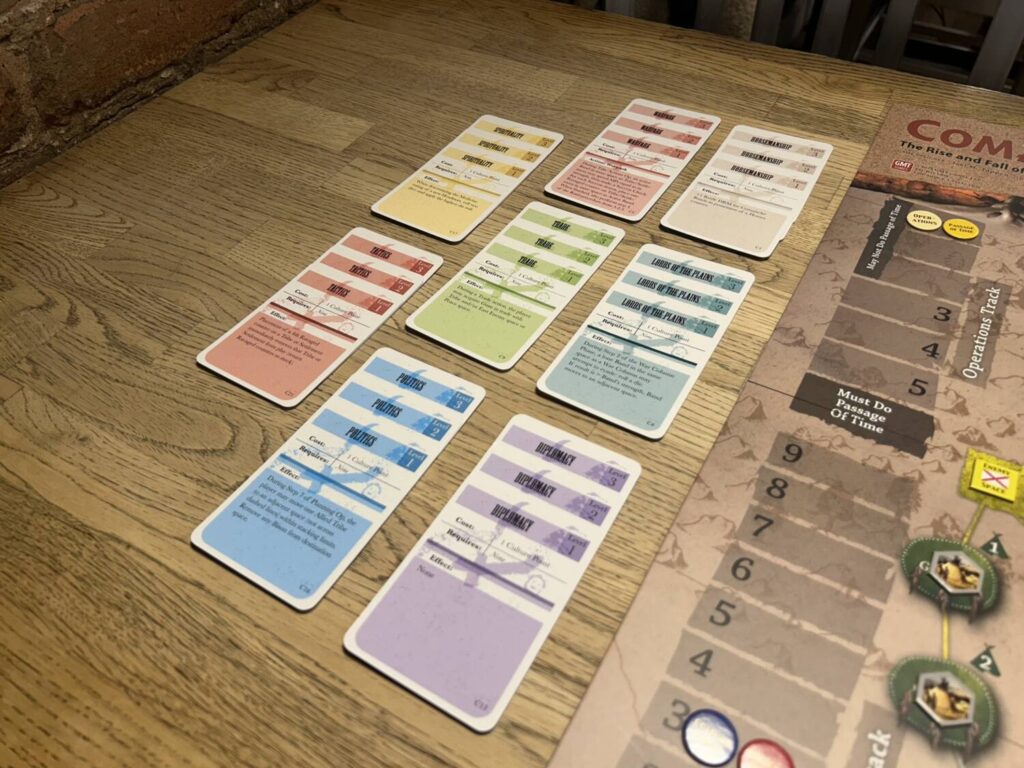 While I tend to focus more on the bigger picture of the game, Comanchería offers plenty as a gamic experience. You have to carefully manage resources and pacing. The more you do in a round, the more points your enemies will have to push you. There’s also great variety in approach. The Culture cards allow players to pursue long-term strategies that follow different contours. Horsemanship and Tactics push military abilities, while Trade and Diplomacy allow you to excel in negotiations. You can express yourself through the Culture cards, taking the approach that most interests you.
While I tend to focus more on the bigger picture of the game, Comanchería offers plenty as a gamic experience. You have to carefully manage resources and pacing. The more you do in a round, the more points your enemies will have to push you. There’s also great variety in approach. The Culture cards allow players to pursue long-term strategies that follow different contours. Horsemanship and Tactics push military abilities, while Trade and Diplomacy allow you to excel in negotiations. You can express yourself through the Culture cards, taking the approach that most interests you.
Comanchería is challenging, impenetrable, and open to player expression, but I love it most for its unusual tempo. I’ve said many times that Comanchería is the closest board games have ever come to a great, lengthy novel. There’s something about the patience with which it unfolds that’s unlike anything else. I enjoy solo games for their mechanisms and their puzzles, but I often find them strangely anxious. The gameplay is such a tight loop that I don’t ever get a chance to breathe. Comanchería is different. I found myself playing for an hour or so at a time, then walking away to do something else. Every time I came back, it felt like sinking down into the sofa and cracking open The Grapes of Wrath.
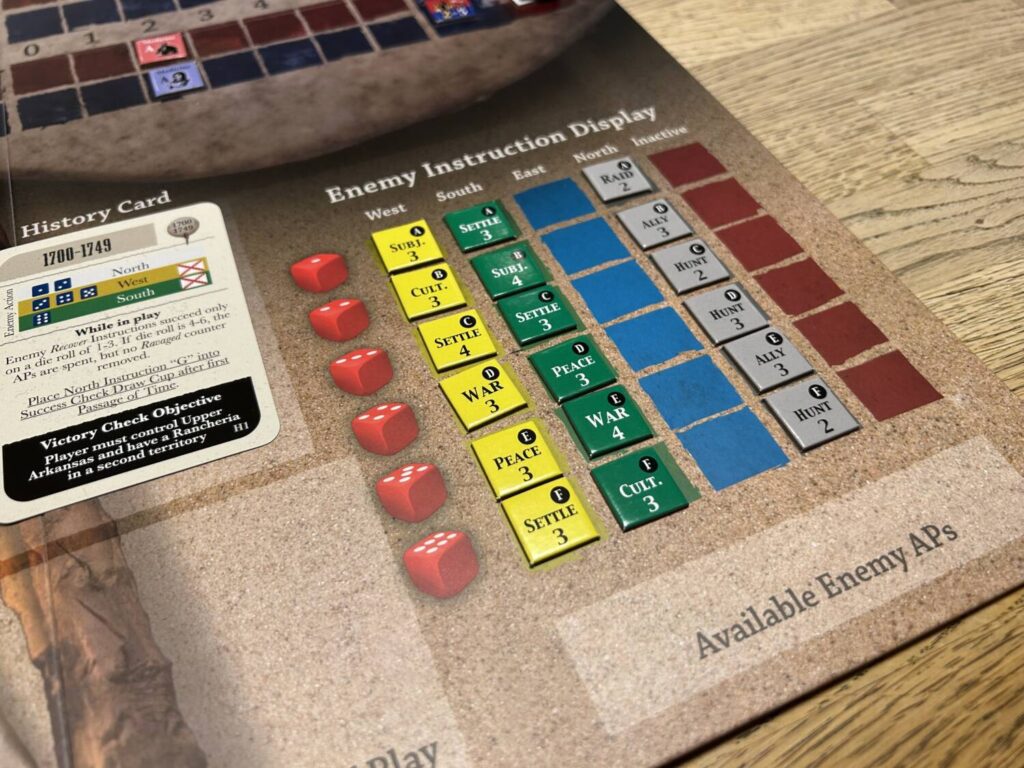
You Might Learn Somethin’
The first few half-centuries of Comanchería are all about slow and methodical expansion. If you make it to the later stages, you watch as your empire inevitably collapses, consumed by the encroaching might of late-1800s America. When I first played the game, I engaged with it uncritically. I approached the design assuming the narrative of the Noble Savage, the idea that indigenous peoples are good and pure and it is we the Europeans who are awful, and that’s what I saw play out.
Having now spent a few years playing Comanchería, having spent time diving into its excellent bibliography, I see something different. The Comanche spread down into the area that would become Comanchería in the early 1700s, driven south by territorial concerns. Once the Utes introduced them to the horse, which they absorbed as a foundation of their society, the Comanche were set on their path. Through shrewd trading, horse breeding, and political maneuvering, they became the dominant power in the region, successfully playing the Spanish and the Americans against one another. Their decline was never inevitable. They were no innocents taken advantage of by another power. The Comanche empire ended for the same reasons as any other. Their leaders grew wealthy and complacent, and extracted more resources than the planet could bear.
To me, Comanchería is as essential as game design gets, though I wouldn’t recommend it to more than one in a hundred people. I probably don’t need to, though. You already know if you’re one of those people. Reading this, you won’t have any doubt. You either are or you aren’t. People who play games like this are born, not made. If you’re inclined, run don’t walk. This is as good, as unique, as authoritative as game design gets.
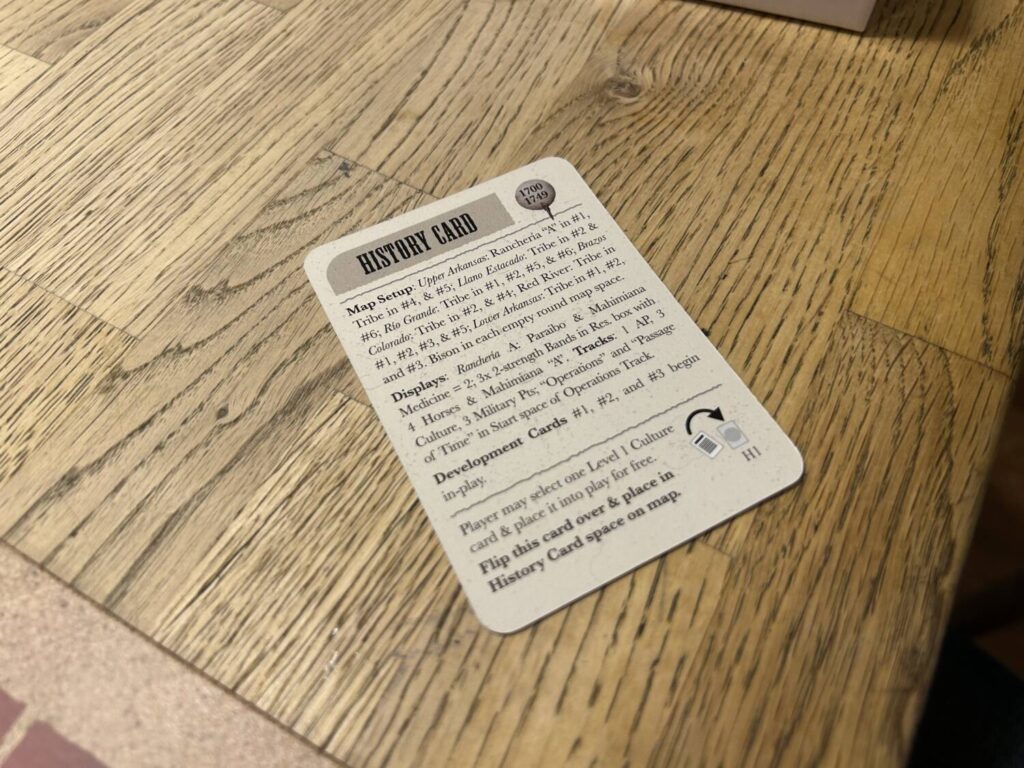


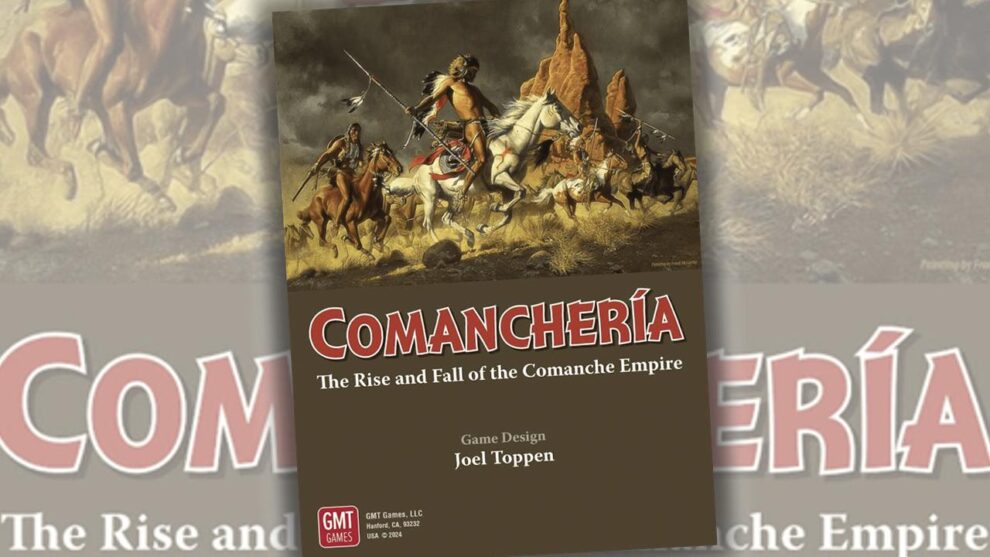









A beautiful review! I really need to see this in the flesh.